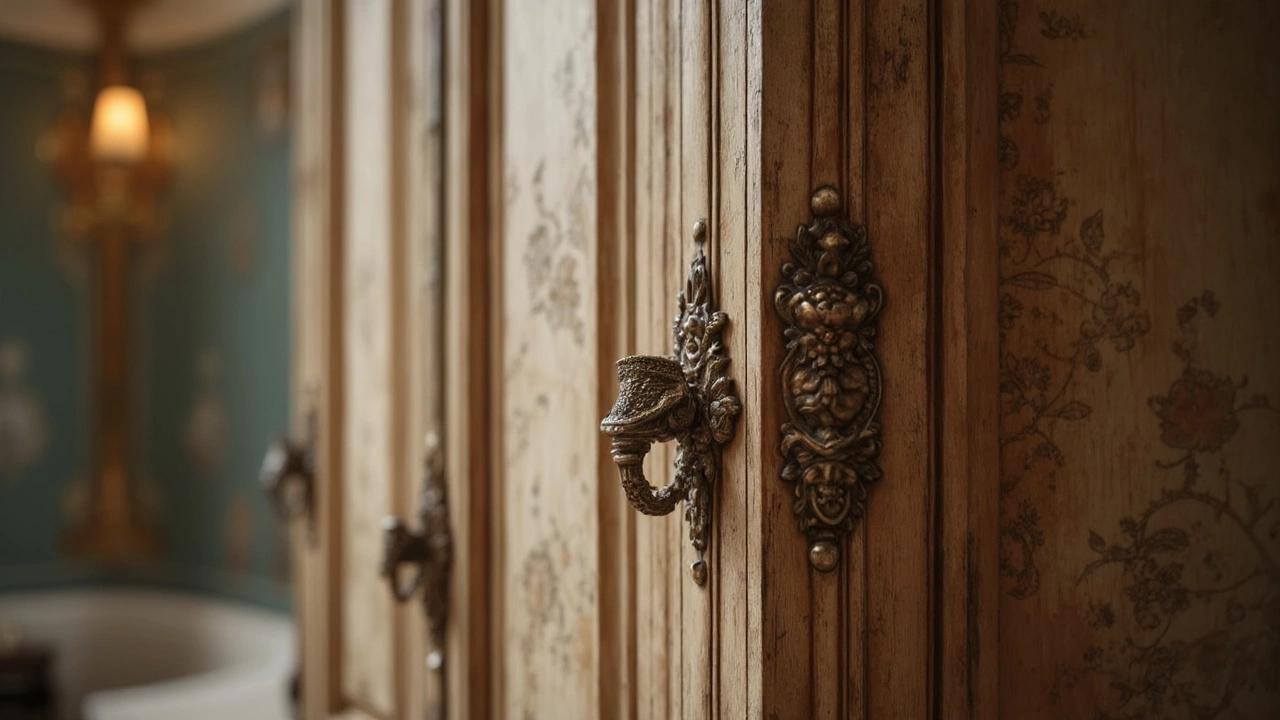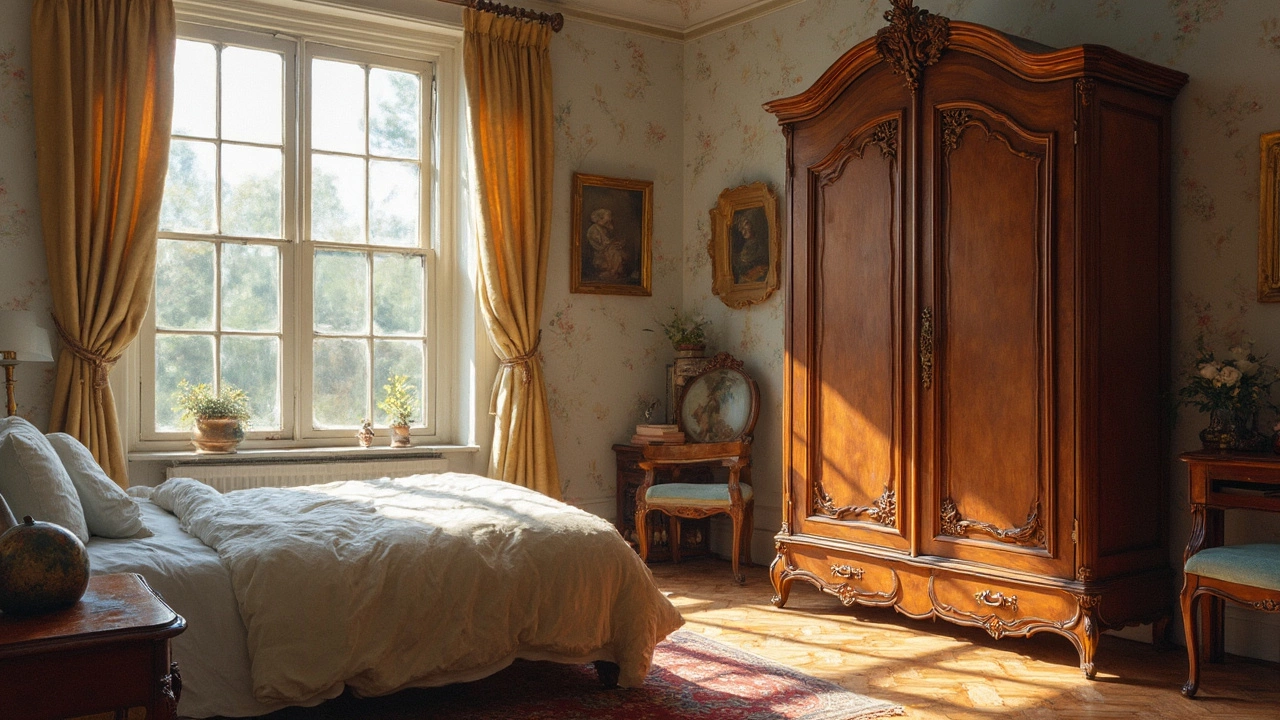If you pop into a French home and spot a big, beautiful piece of wooden furniture with doors, don't call it a wardrobe—call it an armoire. That’s the go-to word in France when you’re talking about a standalone closet for clothes or linens. You won’t really hear “wardrobe” unless someone’s brushing up on their English homework.
So, why “armoire” and not just “closet”? French homes haven’t always had those built-in closets you find in newer apartments in the U.S. or the U.K. The armoire was the main place for keeping clothes safe from dust and moths, way before walk-in closets were even a thing. Today, a lot of French families still use armoires that have been passed down for generations. These aren’t just practical; they’re often a piece of art and family history in one. If you ever try to buy one online or at a flea market, watch out for words like “placard”—that’s more like a basic cupboard or a built-in closet, not the freestanding, often decorative armoire.
- The French Word for Wardrobe
- What Makes an Armoire Unique?
- French Armoires in History and Homes
- Tips for Bringing French Style Home
The French Word for Wardrobe
Walk into a French furniture store and ask for a “wardrobe,” and you’ll probably get a confused look. That’s because the French word for wardrobe is armoire. This term has deep roots in the French language and culture. The word dates back to the 16th century, originally coming from the Latin 'armorium' which referred to a storage chest for armor—shows you how protective these things were, even back then.
Technically, “armoire” means a tall, freestanding cabinet with doors. You stash clothes, linens, sometimes even dishes inside. There’s also “garde-robe,” which pops up in very old French, literally meaning “to guard clothes.” That one’s barely used today outside museum tours or castles.
Now, if you see the word “placard,” that’s not the same. In modern French, a “placard” is more of a built-in closet, like the ones you find in newer apartments. Most people, even kids, will call the big, beautiful furniture piece in grandma’s bedroom an “armoire.”
Here’s a quick look at what these words mean side by side:
| French Term | Literal Meaning | Common Use |
|---|---|---|
| Armoire | Wardrobe/Cabinet | Freestanding furniture for clothes |
| Placard | Closet/Cupboard | Built-in storage, usually with doors |
| Garde-robe | Clothes-guard | Rare, old-fashioned |
One thing to watch for if you’re traveling: some hotels or apartments might list a room having an “armoire,” even if there’s no built-in closet. That’s normal in older French buildings. So if you see it mentioned on an Airbnb description, you’ll know exactly what to expect—which is usually way more stylish than a standard closet anyway.
What Makes an Armoire Unique?
An armoire isn’t just any big piece of furniture for your clothes. What makes it stand out in a French home, and sets it apart from an ordinary wardrobe or closet, is all in the details—both in design and history.
First off, armoire usually means solid wood. The French typically use oak, walnut, or cherry. The doors often have carvings—sometimes floral, sometimes geometric. Many have a curved top or heavy cornices. You won’t find particle board or plastic here. Some armoires even show off brass or iron hardware that’s almost as old as the house itself.
One cool fact: armoires often come in two main pieces for transport. Old French homes have tight staircases, so that design was just practical. You assemble it right in the room. Once it’s up, it stays put for years—these things are heavy.
Want to see how armoires compare to other furniture in a French home? Check out this quick table for a side-by-side:
| Furniture | Used For | Portable | Typical Material |
|---|---|---|---|
| Armoire | Clothes, linens | No (very heavy) | Solid wood |
| Placard | Storage (built-in) | No (part of wall) | Wood, drywall |
| Commode | Folded clothes, miscellaneous | Yes (small) | Wood |
An armoire is also a big deal in French culture. Families sometimes pass down an armoire for generations—it’s practically a family heirloom. You might find a wedding date scratched into the inside, or little stories attached to the carvings.
- If you’re buying one secondhand, check the back. Real armoires still have thick, sturdy boards at the back, not a thin panel.
- Older armoires usually have hand-carved details; if it looks too perfect, it might be new or mass-produced.
- Measurements matter—traditional armoires can be huge, up to 2.5 meters high.
In short, what makes an armoire unique isn’t just how it looks, but how it’s built, how it’s used, and the role it plays in the stories of French families.

French Armoires in History and Homes
French armoires go way back—think medieval castles, not just tiny apartments in Paris. The first armoires showed up in France around the 12th century. Back then, people needed serious storage for both clothes and valuables, since most homes didn’t have closets or even dressers. Originally, they were made super sturdy to keep out mice and keep pricey linens safe.
Jump to the 17th and 18th centuries, and armoires became a statement piece. Kings like Louis XIV had custom armoires built for Versailles, with crazy details: hand-carved wood, gold leaf, and intricate hardware. In regular homes, you’d see walnut or oak, often with simple designs but always solid enough to last forever. Having a big, beautiful armoire was almost like showing off—kind of like having a giant TV in your living room today.
The cool thing is, many old French families still use these antiques. In villages all over France, you’ll see armoires passed down through generations, sometimes as a wedding gift. In the modern era, people still love them for their style—but also because they make storage look good in rooms where there’s no built-in closet.
If you’re hunting for a proper French armoire, look for features like dovetail joints (shows the piece wasn’t slapped together) and solid wood doors. The style tells you a lot about the era—Renaissance armoires had more curves and little details, while later models got more streamlined. Today’s versions can be totally rustic or freshly painted for a farmhouse look.
Whether you pick up an old one at a flea market or get a modern version, an armoire isn’t just for clothes. In France, they stuff them with sheets, towels, paperwork, even kitchen gear. It’s the original all-in-one storage hack—no closet required.
Tips for Bringing French Style Home
If you want your bedroom to feel like it belongs in a Parisian apartment, you don’t have to move to France. Start with the basics: the wardrobe. An authentic French look centers around a classic armoire—think natural wood, elegant curves, and sturdy doors.
- Pick real wood: Most real French armoires are made from oak, walnut, or cherry wood. Veneer and particle board won’t give you the same look or last as long.
- Look for details: Carvings like floral motifs, curved legs (like cabriole legs), and traditional iron or brass handles are giveaway signs of a true French armoire.
- Skip glossy finishes: Traditional French style leans toward matte, natural, or distressed finishes. Too much shine looks modern, not vintage.
- Mix and match: Don’t stress about buying a perfect matching set. French interiors love character, so a unique armoire makes sense next to a modern bed or colorful rug.
If you’re worried about size, French armoires can be pretty big. Standard ones run from about 6 to 8 feet tall and 3 to 6 feet wide. Here’s a quick peek at what you might see when shopping:
| Feature | Typical French Armoire | Modern Closet |
|---|---|---|
| Height | 6-8 ft (1.8-2.4 m) | Usually built-in, varies |
| Width | 3-6 ft (0.9-1.8 m) | Custom fit to room |
| Material | Solid wood | Wood or composites |
| Doors | Swing-out wood doors | Sliding or hinged |
| Drawers/Shelves | Often included | Usually customizable |
When you find an armoire you love, don’t just stuff it with clothes. Use baskets to keep small things in check and hang sachets of lavender (an old French trick) to keep things smelling fresh.
If a real antique is out of your budget, hunt for modern replicas or upcycle an old secondhand wardrobe. A quick DIY chalk-paint job and swapping out plain knobs for some vintage ones can work wonders.


Write a comment